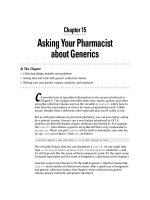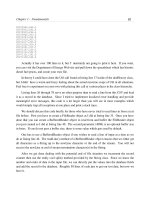About This Course
Bạn đang xem bản rút gọn của tài liệu. Xem và tải ngay bản đầy đủ của tài liệu tại đây (114.56 KB, 4 trang )
About This Course
Course Overview
This section provides you with a brief description of the course, audience,
suggested prerequisites, and course objectives.
Description
This workshop teaches students to analyze business requirements to determine
data storage and data access requirements. Participants will learn to design data
models and the data layer of a Microsoft
®
Windows
®
DNA architecture, and to
select the appropriate Microsoft technologies.
Audience
This course is intended for software developers with a general understanding of
the software development life cycle. These developers are creating data-centric
applications, which require modeling of data storage and data access, including
access to existing data. It is also for database administrators, development leads,
development managers, consultants, and technical and information architects
who have less than six months experience on the job and who are integrating
Microsoft technologies in a data-centric environment.
Student Prerequisites
This course requires that students meet the following prerequisites:
!
A general understanding of the software development life cycle.
!
A general understanding of relational database management systems.
!
A general understanding of the process of gathering and analyzing business
requirements.
Course Objectives
After completing this course, students will be able to:
!
Derive conceptual data requirements from business requirements.
!
Develop entity/relationship (ER) models.
!
Normalize a logical data model.
!
Create an optimized physical data model.
!
Select the appropriate type and location of data integrity rules to implement,
given a set of constraints.
!
Select appropriate data access and data storage technologies for a solution.
viii About This Course
Course Timing
The following schedule is an estimate of the course timing. Your timing may
vary.
Day 1
Start End Module
9:00 9:30 Course Introduction
9:30 9:50 Module 1: Course Overview
9:50 10:20 Activity 1.1: Categorizing Existing Information
10:20 10:30 Break
10:30 10:50 Module 2: Solution Design Processes
10:50 11:20 Activity 2.1: Identifying Services
11:20 12:20 Lunch
12:20 1:00 Module 3: Using a Conceptual Design for Data Requirements
1:00 1:15 Activity 3.1: Identifying Data-Related Use Cases and Data
Requirements
1:15 1:30 Module 3 (continued)
1:30 1:45 Activity 3.2: Relating Data Requirements to Conceptual Design
1:45 2:00 Break
2:00 2:30 Module 4: Deriving a Logical Data Design
2:30 3:00 Activity 4.1 Deriving Entities and Attributes from Data
Requirements
3:00 4:00 Module 4 (continued)
Day 2
Start End Module
9:00 9:30 Day 1 review
9:30 9:50 Activity 4.2 Creating a Logical Data Model
9:50 10:00 Break
10:00 10:30 Module 5: Normalizing the Logical Data Design
10:30 10:50 Activity 5.1: Identifying Keys in the Logical Model
10:50 11:20 Module 5 (continued)
11:20 11:50 Activity 5.2: Normalizing Data
11:50 1:00 Lunch
1:00 1:45 Module 6: Deriving a Physical Data Design
1:45 2:15 Activity 6.1: Translating the Logical Data Design
2:15 2:30 Break
2:30 3:00 Module 6 (continued)
3:00 3:30 Activity 6.2: Optimizing a Physical Data Design
About This Course ix
Day 3
Start End Module
9:00 9:30 Day 2 review
9:30 9:50 Module 7: Implementing Data Integrity
9:50 10:20 Activity 7.1: Identifying Data Integrity Requirements
10:20 10:30 Break
10:30 11:00 Module 7 (continued)
11:00 11:30 Activity 7.2: Determining Data Integrity Implementations
11:30 12:15 Module 8: Designing Data Services
12:15 1:15 Lunch
1:15 1:45 Activity 8.1: Selecting Data Access Technologies
1:45 3:00 Module 9: Data Storage Considerations
3:00 3:10 Break
3:10 3:30 Activity 9.1: Data Quiz
x About This Course
Document Conventions
The following conventions are used in course materials to distinguish elements
of the text.
Convention Use
#
##
#
Indicates an overview, introductory page, or stand-alone
topic. This symbol appears next to a slide title when
additional information on the topic is covered on the pages
that follow. In this situation, a graphic indicates whether
the slide is an overview or introductory slide. This symbol
also appears next to titles of stand-alone slides, which are
not included in the previous section. In this situation, there
is no additional graphic on the slide
bold Represents commands, command options, and portions of
syntax that must be typed exactly as shown. It also
indicates commands on menus and buttons, icons, dialog
box titles and options, and icon and menu names.
italic In syntax statements, indicates placeholders for variable
information. Italic is also used for introducing new terms,
for book titles, and for emphasis in the text.
Title Capitals Indicate domain names, user names, computer names,
directory names, folders, and file names, except when
specifically referring to case-sensitive names. Unless
otherwise indicated, you can use lowercase letters when
you type a directory name or file name in a dialog box or
at a command prompt.
ALL CAPITALS
Indicate the names of keys, key sequences, and key
combinations — for example, ALT+SPACEBAR.
monospace
Represents code samples, examples of screen text, or
entries that you type at a command prompt or in
initialization files.
[ ] In syntax statements, enclose optional items. For example,
[filename] in command syntax indicates that you can
choose to type a file name with the command. Type only
the information within the brackets, not the brackets
themselves.
{ } In syntax statements, enclose required items. Type only
the information within the braces, not the braces
themselves.
| In syntax statements, separates an either/or choice.
!
Indicates a procedure with sequential steps.
... In syntax statements, specifies that the preceding item may
be repeated.
.
.
.
Represents an omitted portion of a code sample.









